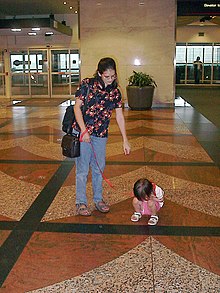Child harness

A child harness (alternative: child tether, child leash, British English: walking reins) is a safety device worn by children when walking with a parent or carer. Child harnesses are most commonly used with toddlers and children of preschool age, though are occasionally used with older children with special supervisory needs such as ADHD or autism. Typically, a harness consists of waist and shoulder straps with a lead (tether) or rein attaching behind, however a simpler version (sometimes called a wrist link) consisting of a single strap connecting the child’s wrist to an adult is also common.
Use
Child harnesses are designed to provide safety for a child when walking by preventing them from being separated from their parent or carer. Additionally, some may be used to help a child stay seated in a stroller or high chair. Typically used for children between one and four years of age, the use of a child harness depends on a variety of factors including the age and maturity of the child, as well as any perceived dangers such as busy roads, large crowds, and potential distractions. Other factors such as neurological and health conditions may also be considered, especially for older children with special supervisory requirements.
The devices are becoming more popular, which has prompted retailers to add more designs.[1] Newer versions often include a backpack or a stuffed animal, with the lead attaching underneath, which softens the appearance.[1]
Types
Standard harness
A harness usually consists of a waist or chest strap, and two shoulder straps. A walking lead or rein attaches at the back or sides and is held by the parent or carer behind the child. Some harnesses can also be used to help keep a child seated in a stroller or high chair. While originally made of leather, modern webbing versions are lighter, often washable, and more compact to store.
Harnesses are most commonly used with children between one and four years of age.[2]
Wrist link
A wrist link (sometimes called a wrist strap or wrist rein), is a simple length of webbing with loops at each end. One loop is worn on the child’s wrist, and the other is held by the parent or carer. Usually, the loops are adjustable for size, and the strap often features an elastic section to prevent injury by absorbing shock from any sudden movements. Some wrist links use a strong coiled plastic line instead of webbing.
Similar to harnesses, wrist links are normally used for children between one and four years of age,[2] however they are sometimes used with older children who have outgrown a harness.[3]
Backpack harness
Backpack harnesses integrate the functions of a child harness and a backpack. Designs may be based around a basic backpack, a stuffed animal, or well-known children’s entertainment character. Backpack harnesses have many of the same features as standard harnesses, but are designed to be more appealing for the child and/or parent.
Similar to standard harnesses, backpack harnesses are normally used with children between one and four years of age.[2]
Other versions
For older children and adolescents who have special supervision requirements due to health or behavioral conditions, larger, and sometimes bespoke, versions of child harnesses are sometimes used.[4][5]
Controversy
There exists a difference of opinion on the use of child harnesses. Some adults disapprove of the use of child harnesses. Those in favor argue that both safety and freedom are improved compared to hand-holding or confinement of children to strollers. In other cases, caregivers who are experienced with children with special needs may find the practice of leashing children to be distasteful or to encourage neglect rather than attentive childcare. Those opposed to their use prefer restraining children through hand-holding, confinement to strollers, or not permitting children who behave badly or wander away to leave their homes.
See also
References
- ^ a b Mann, Effie (14 April 2013). "Parents take lead on child restraints". The Sydney Morning Herald.
- ^ a b c British Standards Institution. (November 2004). BS EN 13210:2004 Child Use and Care Articles — Children’s Harnesses, Reins and Similar Type Articles — Safety Requirements and Test Methods, p.5
- ^ Minett, Pamela. Child Care and Development, 7th Edn. London: Hodder Education, 2017. p.120
- ^ The National Autistic Society, (2017) Autism Services Directory. Available: http://www.autism.org.uk/directory/resources/4262.aspx. Accessed: December 28, 2017
- ^ Autism World Magazine, Resources for Special Needs Handbook (MagsWest Publishing Pty. Ltd., 2015), p.44


